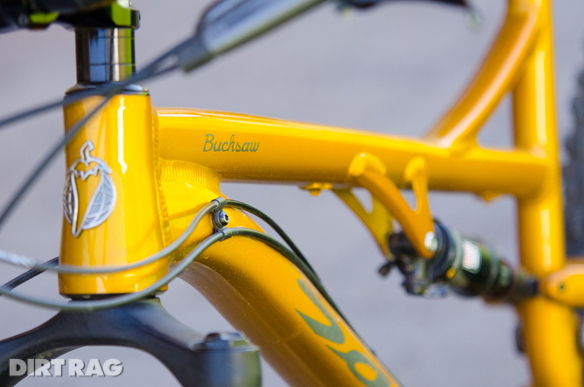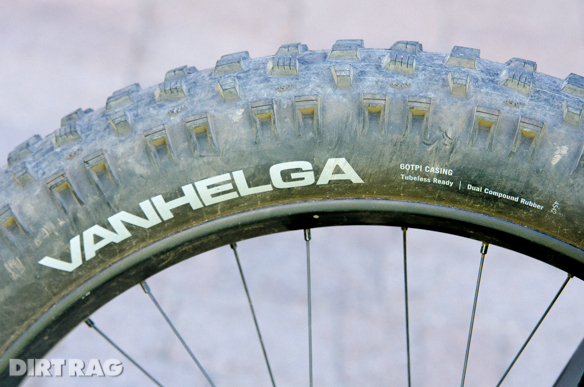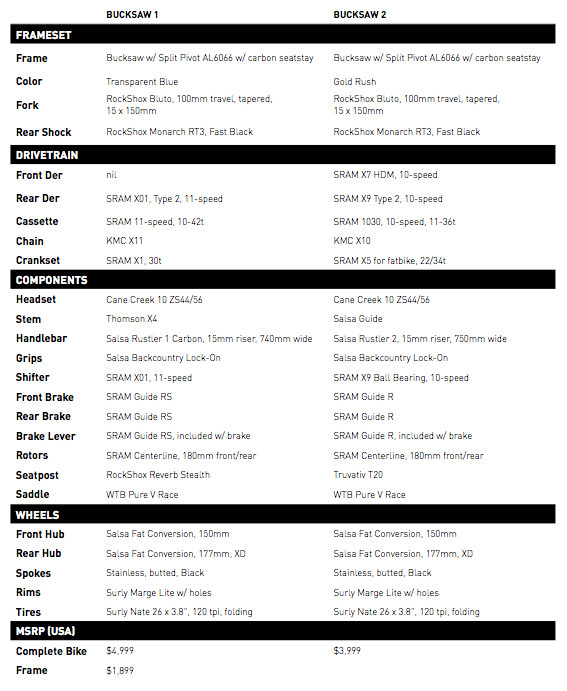First Impression: Riding Salsa’s full-suspension fat bike, the Bucksaw
Originally posted on July 22, 2014 at 1:13 am
We had seen it coming. There were spy shots and rumors tossed around about a full-suspension fat bike. In fact, the Bucksaw isn’t even the first one—several smaller brands have built bikes that qualified as “full-suspension”, but this one is different. This is a major brand making a big commitment to a new product segment, and bringing an advanced suspension design with it. Mike Riemer, Salsa’s Marketing Manager, said that Dave Weagle, the creator of the Bucksaw’s Split Pivot suspension, told him it was the most complex project he had ever worked on.
One thing is for sure, this is not a “stealthy” bike. From the big tires to the candy-colored paint, the Bucksaw is breaking a new trail in mountain biking. But how does it ride?
First let’s start with the design. Salsa began licensing Weagle’s Split Pivot design last year, and first introduced it on the second-generation Spearfish and Horsethief 29ers. When we bumped into Riemer on the trail a few years back, he was riding a prototype with the previous suspension design. The advantage of the Split Pivot is that the high main pivot keeps pedal bob to a minimum, while the pivot concentric with the rear axle eliminates brake jack and keeps thing moving while decelerating.

In practice it translates to 100mm of rear wheel travel controlled with a standard RockShox Monarch RT3 shock. While the prototypes used a variety of cobbled-together forks, the arrival of the RockShox Bluto is what really allowed this bike to happen. Salsa admits they pushed RockShox pretty hard to make the fork a reality, and the bike simply wouldn’t exist without it.

You’ll also note the largest tire you can fit in the Bucksaw is a 26×40. You might be able to squeeze in a 29+ tire, but it would likely be too tall to fit in the frame. This demo bike I rode was fitted with Whisky’s new carbon, tubeless rims and 45NRTH Van Helga tubeless fat tires. The front axle spacing is 150mmx15mm and the rear is 177mmx12mm, with thru-axles at both ends. Other relevant frame details include a 67.6-degree head tube angle, 17.4-inch chainstays and a 121mm PressFit bottom bracket.
Beyond the trail
So how does it translate to actual mountain biking? I’ll try to explain the feeling this way: If you’ve ridden a fat bike you’re familiar with the way the big tires can flatten terrain and mute vibrations. The Bucksaw takes that same feeling and applies it to a full-suspension bike. It “rides” like a full-suspension mountain bike that just happens to have big tires, similar to how a rigid fat bike rides like a rigid mountain bike.
Setting up the bike isn’t dissimilar to a regular bike, though most experienced riders recommend a slightly higher tire pressure than on a rigid fat bike—and by “higher” we mean 10-15 psi. Because the tires aren’t asked to work as any sort of suspension, the actual suspension can do the work while the tires do what they do best: traction and control.

That traction is immediately apparent while climbing, especially on the loose surfaces of the Utah trails where I rode sampled it. Sit and spin or stand and mash, that rear tire is going to hook up. It’s also amazingly apparent when braking, as the massive amount of rubber on the ground can slow you down in a hurry.
With the rebound settings on the suspension set close to full “rabbit” (less damping, faster rebound), the Bucksaw is surprisingly light on it’s feet. It can pivot around tight switchbacks as well, if not better, than a long-travel 29er. I’m sure the light weight wheel and tire package helps in this regard as well. The damping of the tires and the suspension really work together well on braking bumps and low-profile rock gardens too.

What doesn’t it do? It obviously will never be able to match the weight of a comparable bike, and I doubt it will ever be as fast or as capable in extreme terrain as a long travel 29er. But if a more robust fork existed (say a fat bike version of the Pike) and was mated to a slightly more relaxed head tube angle it could be a serious terror on fast descents. Could there be a bigger brother in the works for the Bucksaw? We’ll have to wait and see.
My takeaway from my (far too brief) ride on the Bucksaw is this: Is it faster? Maybe? Is it better? That’s a loaded question. Is it fun? Oh hell yeah.

Specs

Geometry
